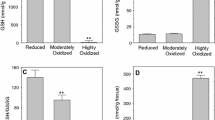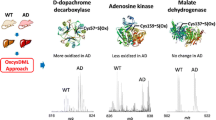Abstract
The mechanisms by which neurons maintain redox homeostasis, disruption of which is linked to disease, are not well known. Hydrogen peroxide, a major cellular oxidant and neuromodulator, can promote reversible oxidations of protein thiols but the scope, targets, and significance of such oxidations occurring in neurons, especially in vivo, are uncertain. Using redox phenylarsine oxide (PAO)-affinity chromatography, which exploits the high-affinity of trivalent arsenicals for protein dithiols, this study investigated the occurrence of reducible and, therefore, potentially regulatory, protein disulfide bonds in Triton X-100-soluble protein fractions from isolated nerve-endings (synaptosomes) prepared from rat brains. Postmortem oxidations of protein thiols were limited by rapidly freezing the brains following euthanasia and, later, homogenizing them in the presence of the N-ethylmaleimide to trap reduced thiols. The reducible disulfide proteome comprised 5.4% of the total synaptosomal protein applied to the immobilized PAO columns and was overrepresented by pathways underlying ATP synaptic supply and demand including synaptic vesicle trafficking. The alpha subunits of plasma membrane Na+, K+-ATPase and the mitochondrial ATP synthase were particularly abundant proteins of the disulfide proteome and were enriched in this fraction by 3.5- and 6.7-fold, respectively. An adaptation of the commonly used “biotin-switch” method provided additional support for selective oxidation of thiols on the alpha subunit of the ATP synthase. We propose that reversible oxidations of protein thiols may underlie a coordinated metabolic response to hydrogen peroxide, serving to both control redox signaling and protect neurons from oxidant stress.




Similar content being viewed by others
Abbreviations
- Biotin-HPDP:
-
N-[6-(Biotinamido)hexyl]-3′-(2′-pyridyldithio)-propionamide
- CaN:
-
Calcineurin
- DTT:
-
Dithiothreitol
- FT:
-
Flow-through
- GAPDH:
-
Glyceraldehyde-3-phosphate dehydrogenase
- GSH:
-
Glutathione
- KHH:
-
Krebs–Henseleit–HEPES
- LW:
-
Last wash
- LC–MS/MS:
-
Liquid chromatography-tandem mass spectrometry
- NEM:
-
N-ethylmaleimide
- NNT:
-
Nicotinamide nucleotide transhydrogenase
- PAO:
-
Phenylarsine oxide
- PPP:
-
Pentose phosphate pathway
- ROS:
-
Reactive oxygen species
- TCEP:
-
Tris(2-carboxyethyl)phosphine
- Trx:
-
Thioredoxin
References
Massaad CA, Klann E (2011) Reactive oxygen species in the regulation of synaptic plasticity and memory. Antioxid Redox Signal 14:2013–2054. https://doi.org/10.1089/ars.2010.3208
Hongpaisan J, Winters CA, Andrews SB (2004) Strong calcium entry activates mitochondrial generation, upregulating kinase signaling in hippocampal neurons. J Neurosci 24:10878–10887. https://doi.org/10.1523/JNEUOSCI.3278-04.2004
Cobley JN (2018) Synapse pruning: Mitochondrial ROS with their hands on the shears. BioEssays 40:e1800031. https://doi.org/10.1002/bies.201800031
Foley TD (2019) Reductive reprogramming: A not-so-radical hypothesis of neuro-degeneration linking redox perturbations to neuroinflammation and excitotoxicity. Cell Mol Neurobiol 39:577–590. https://doi.org/10.1007/s10571-019-00672-w
Papadia S, Soriano FX, Leveille F, Martel MA, Dakin KA, Hansen HH, Kaindl A, Sifringer M, Fowler J, Stefovska V, McKenzie G, Craigon M, Corriveau R, Ghazal P, Horsburgh K, Yankner BA, Wyllie DJ, Ikinomidou C, Hardingham GE (2008) Synaptic NMDA receptor activity boosts intrinsic antioxidant defenses. Nat Neurosci 11:476–487. https://doi.org/10.1038/nn2071
Baxter PS, Bell KF, Hasel P, Kaindl AM, Fricker M, Thomson D, Cregan SP, Gillingwater TH, Hardingham GE (2015) Synaptic NMDA receptor activity is coupled to the transcriptional control of the glutathione system. Nat Commun 6:6761. https://doi.org/10.1038/ncomms7761
Ren X, Zou L, Zhang X, Branco V, Wang J, Carvalho C, Holmgren A, Lu J (2017) Redox signaling mediated by thioredoxin and glutathione systems in the central nervous system 27:989–1010. https://doi.org/10.1089/ars.2016.6925
Rasler M, Wamelink MM, Kowald A, Gerisch B, Heeren G, Struys EA, Klipp E, Jakobs C, Breitenbach M, Lehrach H, Krobitsch S (2007) Dynamic rerouting of the carbohydrate flux is key to counteracting oxidative stress. J Biol 6:10. https://doi.org/10.1186/jbiol61
Peralta D, Bronowska AK, Morgan B, Doka E, Van Laer K, Grater F, Dick TP (2015) A proton relay enhances H2O2 sensitivity of GAPDH to facilitate metabolic adaptation. Nat Chem Biol 11:156–163. https://doi.org/10.1038/nchembio.1720
Lu J, Holmgren A (2014) The thioredoxin antioxidant system. Free Radic Biol Med 66:75–87. https://doi.org/10.1016/j.freeradbiomed.2013.07.036
Randall LM, Ferrer-Sueta G, Denicola A (2013) Peroxiredoxins as preferential targets in H2O2-induced signaling. Methods Enzymol. 527:41–63. https://doi.org/10.1016/B978-0-12-405882-8.00003-9
Chiu J, Hogg PJ (2019) Allosteric disulfides: sophisticated molecular structures enabling flexible protein regulation. J Biol Chem 294:2929–2960. https://doi.org/10.1074/jbc.REV118.005604
Saurin AT, Neubert H, Brennan JP, Eaton P (2004) Widespread sulfenic acid formation in tissues in response to hydrogen peroxide. Proc Natl Acad Sci USA 101:17982–17987. https://doi.org/10.1073/pnas.0404762101
Eaton P, Shattock MJ (2002) Purification of proteins susceptible to oxidation at cysteine residues: identification of malate dehydrogenase as a target for S-glutathionylation. Ann NY Acad Sci 973:529–532. https://doi.org/10.1111/j.1749-6632.2002.tb04694.x
Lind C, Gerdes R, Hammell Y, Schuppe-Koistinen I, von Lowenhielm HB, Holmgren A, Cotgreave IA (2002) Identification of S-glutathionylated cellular proteins during oxidative stress and constitutive metabolism by affinity purification and proteomic analysis. Arch Biochem Biophys 406:229–240. https://doi.org/10.1016/s0003-9861(02)00468-x
Rehder DS, Borges CR (2010) Cysteine sulfenic acid as an intermediate in disulfide bond formation and nonenzymatic protein folding. Biochemistry 49:7748–7755. https://doi.org/10.1021/bi1008694
Beer SM, Taylor ER, Brown SE, Dahm CC, Costa NJ, Runswick MJ, Murphy MP (2004) Glutaredoxin 2 catalyzes the reversible oxidation and glutathionylation of mitochondrial membrane thiols proteins: Implications for mitochondrial redox regulation and antioxidant DEFENSE. J Biol Chem 279:47939–47951. https://doi.org/10.1074/jbc.M408011200
Wolhuter K, Whitwell HJ, Switzer CH, Burgoyne JR, Timms JF, Eaton P (2018) Evidence against stable protein S-nitrosylation as a widespread mechanism of post-translational regulation. Mol Cell 69:438–450. https://doi.org/10.1016/j.molcel.2017.12.019
Stocker S, Van Laer K, Mijuskovic A, Dick TP (2018) The conundrum of hydrogen peroxide signaling and the emerging role of peroxiredoxins as redox relay hubs. Antioxid Redox Signal 28:558–573. https://doi.org/10.1089/ars.2017.7162
Foley TD, Stredny CN, Coppa TM, Gubbiotti MA (2010) An improved phenylarsine oxide-affinity method identifies triose phosphate isomerase as a candidate redox receptor protein. Neurochem Res 35:306–314. https://doi.org/10.1007/s11064-009-0056-z
Adams E, Jeter D, Cordes AW, Kolis JW (1990) Chemistry of organometalloid complexes with potential antidotes: structure of an organoarsenic(III) dithiolate ring. Inorg Chem 248:1500–1503
Foley TD, Cantarella KM, Gillespie PF, Stredny ES (2014) Protein vicinal thiol oxidations in the healthy brain: not so radical links between physiological oxidative stress and neural cell activities. Neurochem Res 39:2030–2039. https://doi.org/10.1007/s11064-014-1378-z
Li R, Kast J (2017) Biotin switch assays for quantitation of reversible cysteine oxidation. Methods Enzymol 585:269–284. https://doi.org/10.1016/bs.mie.2016.10.006
Michaelis ML, Jiang L, Michaelis EK (2017) Isolation of synaptosomes, synaptic plasma membranes, and synaptic junctional complexes. Methods Mol Biol 1538:107–119. https://doi.org/10.1007/978-1-4939-6688-2_9
Mi H, Muruganujan A, Casagrande JT, Thomas PD (2013) Large-scale gene function analysis with the PANTHER classification system. Nat Protocol 8:1551–1566. https://doi.org/10.1038/nprot.2013.092
Lundgren DH, Hwang SI, Wu L, Han DK (2010) Role of spectral counting in quantitative proteomics. Expert Rev Proteomics 7:39–53. https://doi.org/10.1586/epr.09.69
Thomas GD, O'Rourke B, Sikkink R, Marban E, Victor RG (1997) Differential modulation of cortical synaptic activity by calcineurin (phosphatase 2B) versus phosphatases 1 and 2A. Brain Res 749:101–108. https://doi.org/10.1016/s0006-8993(96)01305-4
Marcaida G, Kosenko E, Minana MD, Grisolia S, Felipo V (1996) Glutmate induces a calcineurin-mediated dephosphorylation of Na+, K(+)-ATPase that results in its activation in cerebellar neurons in culture. J Neurochem 66:99–104. https://doi.org/10.1046/j.1471-4159.1996.66010099.x
Sun T, Wu XS, Xu J, McNeil BD, Pang ZP, Yang W, Bai L, Qadri S, Molkentin JD, Yue DT, Wu LG (2010) The role of calcium/calmodulin-activated calcineurin in rapid and slow endocytosis at central synapses. J Neurosci 30:11838–11847. https://doi.org/10.1523/JNEUROSCI.1481-10.2010
Foley TD, Katchur KM, Gillespie PF (2016) Disulfide stress targets modulators of excitotoxicity in otherwise healthy brains. Neurochem Res 41:2763–2770. https://doi.org/10.1007/s11064-016-1991-0
Gevondyan NM, Gevondyan VS, Modyanov NN (1993) Location of disulfide bonds in the Na+, K(+)-ATPase alpha subunit. Biochem Mol Biol Int 30:347–355
Bencsath FA, Shartava A, Monteiro CA, Goodman SR (1996) Identification of the disulfide-linked peptide in irreversibly sickled cell beta-actin. Biochemistry 35:4403–4408. https://doi.org/10.1021/bi960063n
Chaudhuri AR, Khan IA, Luduena RF (2001) Detection of disulfide bonds in bovine brain tubulin and their role in protein folding and microtubule assembly in vitro: a novel disulfide detection approach. Biochemistry 40:8834–8841. https://doi.org/10.1021/bi0101603
Halestrap AP, Woodfield KY, Connern CP (1997) Oxidative stress, thiol reagents, and membrane potential modulate the mitochondrial permeability transition by affecting nucleotide binding to the adenine nucleotide translocase. J Biol Chem 272:3346–3354. https://doi.org/10.1074/jbc.272.6.3346
Uniprot Consortium (2019) Uniprot: A worldwide hub of protein knowledge. Nucleic Acids Res 47:D506–D515. https://doi.org/10.1093/nar/gky1049
Garcia J, Han D, Sancheti H, Yap LP, Kaplowitz N, Cadenas E (2010) Regulation of mitochondrial glutathione redox status and protein glutathionylation by respiratory substrates. J Biol Chem 285:39646–39654. https://doi.org/10.1074/jbc.M110.164160
Cobley JN, Noble A, Jimenez-Fernandez E, Valdivia Moya MT, Guille M, Husi H (2019) Catalyst-free click PEGylation reveals substantial mitochondrial ATP synthase subunit alpha oxidation before and after fertilisation. Redox Biol 26:101258. https://doi.org/10.1016/j.redox.2019.101258
Cobley J, Nobe A, Bessell R, Guille M, Husi H (2020) Reversible thiol oxidation inhibits the mitochondrial ATP synthase in Xenopus laevis oocytes. Antioxidants 9:E215. https://doi.org/10.3390/antiox9030215
Bianchet MA, Hullihen J, Pedersen PL, Amzel LM (1998) The 2.8-A structure of rat liver F1-ATPase: configuration of a critical intermediate in ATP synthesis/hydrolysis. Proc Natl Acad Sci USA 95:11065–11070. https://doi.org/10.1073/pnas.95.19.11065
Wouters MA, Fan SW, Haworth NL (2010) Disulfides as redox switches: from molecular mechanisms to functional significance. Antioxid Redox Signal 12:53–91. https://doi.org/10.1089/ARS.2009.2510
Petrushanko IY, Yakushev S, Mitkevich VA, Kamanina YV, Ziganshin RH, Meng X, Anashkina AA, Makro A, Lopina OD, Gasmann M, Makarov AA, Bogdanova A (2012) S-Glutathionylation of the Na, K-ATPase catalytic α subunit is a determinant of the enzyme redox sensitivity. J Biol Chem 287:32195–32205. https://doi.org/10.1074/jbc.M112.391094
Drechsel DA, Patel M (2010) Respiration-dependent H2O2 removal in brain mitochondria via the thioredoxin/peroxiredoxin system. J Biol Chem 285:27850–27858. https://doi.org/10.1074/jbc.M110.101196
Mailloux RJ (2018) Mitochondrial antioxidants and the maintenance of cellular hydrogen peroxide levels. Oxid Med Cell Longevity 2018:7857251. https://doi.org/10.1155/2018/7857251
Mailloux RJ (2020) Protein S-glutathionylation reactions as a global inhibitor of cell metabolism for the desensitization of hydrogen peroxide signals. Redox Biol 32:101472. https://doi.org/10.1016/j.redox.2020.101472
Martinez-Reyes I, Cuezva JM (2014) The H(+)-ATPase: a gate to ROS-mediated cell death or cell survival. Biochim Biophys Acta 1837:1099–1112. https://doi.org/10.1016/j.bbabio.2014.03.010
Barinova KV, Serebryakova MV, Muronetz VI, Schmalhausen EV (2017) S-Glutathionylation of glyceraldehyde-3-phosphate dehydrogenase induces formation of C150–C154 intrasubunit disulfide bond in the active site of the enzyme. Biochim Biophys Acta 1861:3167–3177. https://doi.org/10.1016/j.bbagen.2017.09.008
Bernstein BW, Bamburg JR (2003) Actin-ATP hydrolysis is a major energy drain for neurons. J Neurosci 23:1–6
Rangaruju V, Calloway N, Ryan TA (2014) Activity-driven local ATP synthesis is required for synaptic function. Cell 156:825–835. https://doi.org/10.1016/j.cell.2013.12.042
Bogumil R, Namgaladze D, Schaarschmidt D, Schmactel T, Hellstern S, Mutzel R, Ullrich V (2000) Inactivation of calcineurin by hydrogen peroxide and phenylarsine oxide. Evidence for a dithiol-disulfide equilibrium and implications for redox regulation. Eur J Biochem 267:1407–1415. https://doi.org/10.1046/j.1432-1327.2000.01133.x
Halpain S, Hipolito A, Saffer L (1998) Regulation of F-actin stability in dendritic spines by glutamate receptors and calcineurin. J Neurosci 18:9835–9844
Acknowledgements
The authors thank the University of Scranton for the financial support for this work. They also thank Ms. Courtney Higgins for technical support and Mr. Richard Trygar for administrative support and of this project.
Funding
This work was not supported by external funding.
Author information
Authors and Affiliations
Contributions
TDF designed the study, supervised the performance of the work and the collection and analyses of data, and wrote most of the manuscript. GM and MCA performed all of the laboratory work, including refinement of methods, and contributed to data analyses and manuscript preparation. All authors approved the final paper.
Corresponding author
Ethics declarations
Conflict of interest
The authors declared that they have no conflict of interest.
Ethical Approval
The study was approved by the Institutional Animal Care and Use Committee of the University of Scranton (2019, Protocol #7-19).
Additional information
Publisher's Note
Springer Nature remains neutral with regard to jurisdictional claims in published maps and institutional affiliations.
Electronic supplementary material
Below is the link to the electronic supplementary material.
Rights and permissions
About this article
Cite this article
Foley, T.D., Montovano, G. & Camacho Ayala, M. The Reducible Disulfide Proteome of Synaptosomes Supports a Role for Reversible Oxidations of Protein Thiols in the Maintenance of Neuronal Redox Homeostasis. Neurochem Res 45, 1825–1838 (2020). https://doi.org/10.1007/s11064-020-03046-7
Received:
Revised:
Accepted:
Published:
Issue Date:
DOI: https://doi.org/10.1007/s11064-020-03046-7




